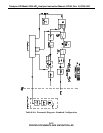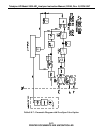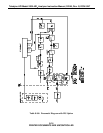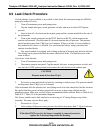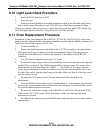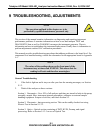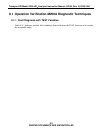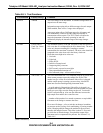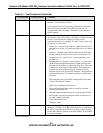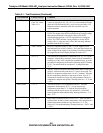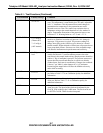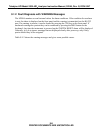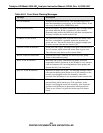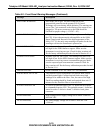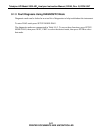
Teledyne API Model 200A NO
X
Analyzer Instruction Manual, 02246, Rev. G, DCN 5247
Table 9-9-1: Test Functions
Test Function Factory Set-Up Comment
RANGE 500PPB This is the Range of the instrument. In standard configuration all 3
outputs have the same range.
Independent range option allows different ranges for each output.
When enabled, there will be 3 range values displayed.
Auto range option allows 2 different ranges for all outputs, and
will automatically switch to the other range dynamically as
concentration values require. The TEST values will show the
range the instrument is currently operating in, and will
dynamically display the alternate range as the range changes
occur.
STABIL Check value in
Final Test Values
Table 2-2-6
Th
e instru
ment stability is the Std. Deviation of the last 10 min of
NO
x
conc data. It is computed for the NO
x
channel only. The noise
value only becomes meaningful if sampling a constant
concentration for more than 20 minutes. The noise value should be
compared to the value observed in the factory check-out.
Faults that cause high noise values are:
1. Gas leaks
2. Light leak
3. Faulty HVPS
4.
Defective Preamp board
5.
Outgassing Moly converter
6.
PMT recently exposed to room light
7.
Dirty/contaminated reaction cell
8.
Mis-calibrated (slope - offset outside of limits)
SAMPLE FLW
500 cc/min
± 50
This is the instrument flow. It is computed using the up stream and
down stream pressures across the sample flow orifice. This
method can give a false flow indication if the orifice is plugged
and the sample pump is creating a pressure drop. It should be
taken into account when diagnosing instrument faults.
- A rapid method of determining if the orifice is plugged is to
disconnect the sample and ozone tubes from the reaction cell, then
briefly put your finger over the fittings on the cell. You should
feel the vacuum build up. Also note the difference between the
high sample flow and the low ozone flow rate.
- Another reliable method is to attach a rotameter or soap bubble
flowmeter to the fittings to measure the flows.
Flow rate will change
± a few cc/min due to changes in ambient
air pressure such as cycling of air conditioning, or passing weather
fronts. Changing altitude changes the ambient air pressure and
therefore the sample flowrate. This effect is about 15-20 cc/min
per 1000 feet of altitude change. If required the output of the
instrument can be compensated for pressure. See Section 5.3.9,
Table 9-9-5.
(table continued)
9-4
PRINTED DOCUMENTS ARE UNCONTROLLED



